While buying a carbon monoxide detector at my local hardware store, I saw a home radon gas test kit on sale. I knew radon gas was bad, but not much else. So I bought a radon test kit just to have some peace of mind. Glad I did. After smoking, radon is the second leading cause of lung cancer in the United States, and my radon gas test results were toxic. I was in the middle of a radon mitigation emergency and needed immediate radon gas removal from my home.
My Toxic Radon Gas Levels
The average home basement has a radon level of 2 pCi/L or lower. My basement had a frightening radon level of 23.3. Just breathing the air in my house was the equivalent to smoking two packs of cigarettes a day. Not a good situation for anyone, especially a home with small children. Radon gas kills 58 Americans every day. I didn’t want my family to be a radon casualty statistic. I had a radon gas removal emergency.
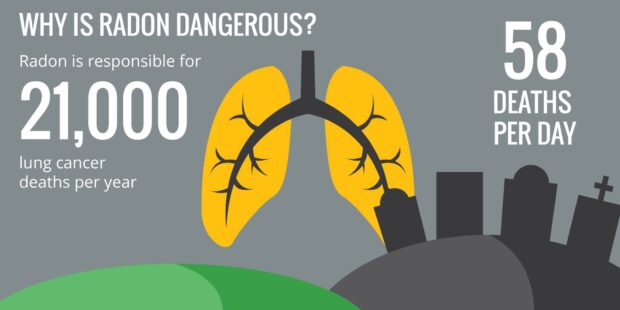
And it’s not like I live near a copper mine or somewhere potentially dangerous. Radon gas is everywhere. Radon is an invisible and odorless naturally occurring gas that seeps out of the earth. The negative pressure in our homes and apartment buildings acts as a funnel that pulls the gas out of the ground and into our living areas.
Here’s what you need to do a protect your home from radon gas and facilitate any necessary radon gas removal.
01) Buy A Radon Gas Test Kit ASAP
A home radon gas test kit is cheap ($15-$40). It’s worth the peace of mind that it will give you and your family. Radon test kits usually range between $10-15 dollars and include the laboratory test fee. The kits are basically just a small box of activated charcoal that you leave on the lowest level of your house for a few days and then mail to a lab.
The radon gas test kit will come with instructions that you should follow exactly. But they usually will tell you not to put the kit directly on the floor and not to mess with or move the kit during the test.
We paid for a home inspection before we bought our house but unbeknownst to us, it did NOT include a(Amazon link) radon gas test. Now I know better. Always get a radon gas test before you move into a new place. It might save a life.
02) Call Your State Radon Office With Your Radon Gas Test Results
Once you get your radon test kit results, call your State radon officer to discuss them. Contact info for local radon representatives for every US state and territory can be found on EPA.gov’s website. Your state radon representative will be able to help interpret your results, provide insights relevant for your neighborhood, and recommend a Radon Mitigation Contractor to help you.
Don’t feel too bad if you have a high radon level. According to this radon map on the EPA’s website, most states north of Arizona to North Carolina have an average radon level of 4 or higher (shown below in RED).
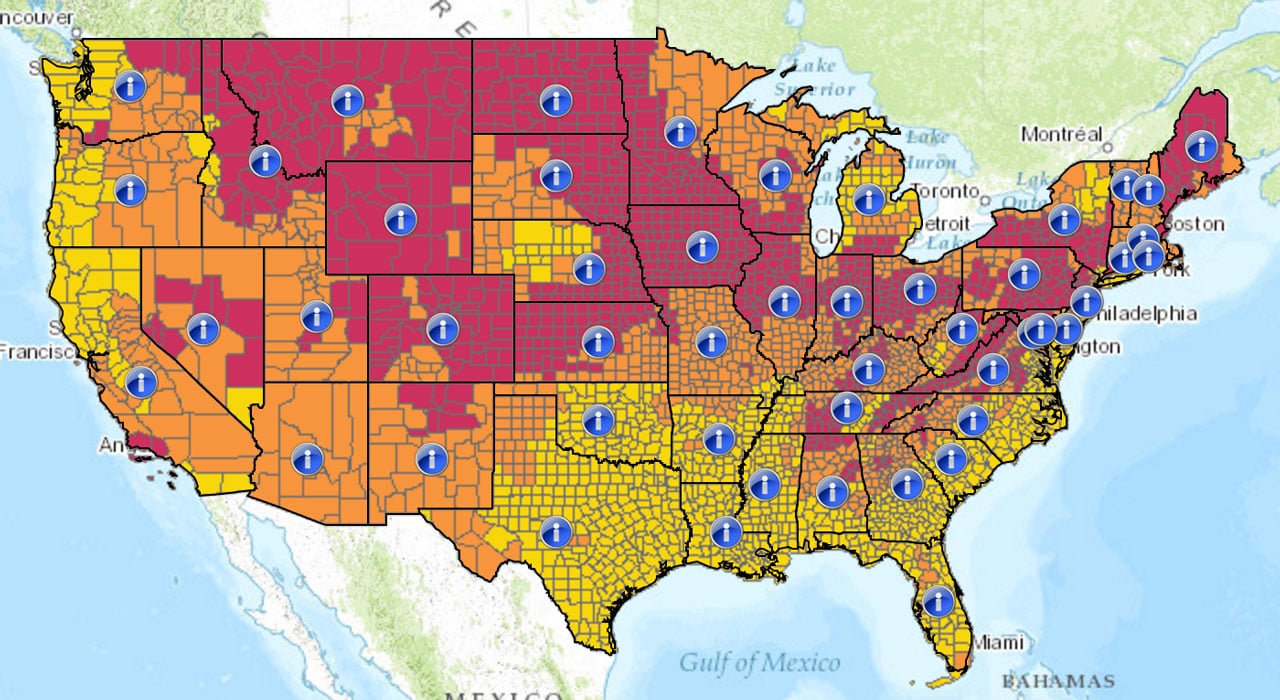
03) Hire A Radon Mitigation Contractor To Facilitate Your Radon Gas Removal Efforts
If your home tests at 4 picoCuries per liter (pCi/L) or above, then you should get a couple of bids from a local radon mitigation contractor. Your radon gas removal needs to happen as soon as possible. Ask for recommendations from your State’s environmental or health departments when you call them to discuss your radon test results. The state recommended contractors will already be cleared by the National Radon Safety Board (NRSB) or the National Radon Proficiency Program (NEHA-NRPP) for radon mitigation.
What should you expect from a radon mitigation contractor? They will typically drill a 6-8 inch hole in your foundation to create an easy escape point for the radon gas. They then will cover that hole with a special radon fan. Attached to that fan will be a pipe that runs through the inside of your house and out either your roof or a side of the house away from any windows.
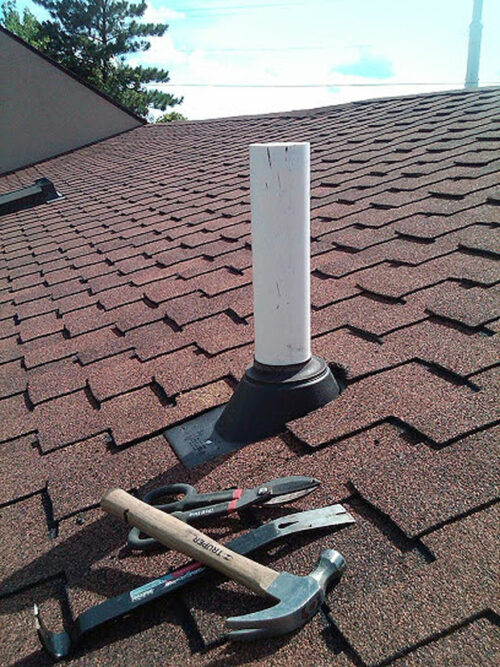
Exact costs will vary from state to state and home to home, but on average you’ll probably get a bill for around $1,000-3,000.
My radon mitigation contractor ran a vent from my basement, through my garage, through the 2nd-floor utility room, through the arctic, and then out the roof. It took him about 7 hours.
04) Patch Holes, Cracks & Gaps
Do you have cracks in your foundation or cement floor? Drafty basement windows? Uncapped sump vents? What about gaps in the concrete around pipes or windows? If so, then you should seal them all ASAP with a product like(Amazon link) SEAL-KRETE or a concrete bonding adhesive.
You want to prevent radon from finding ways to seep into your house. Fewer holes and gaps are better.
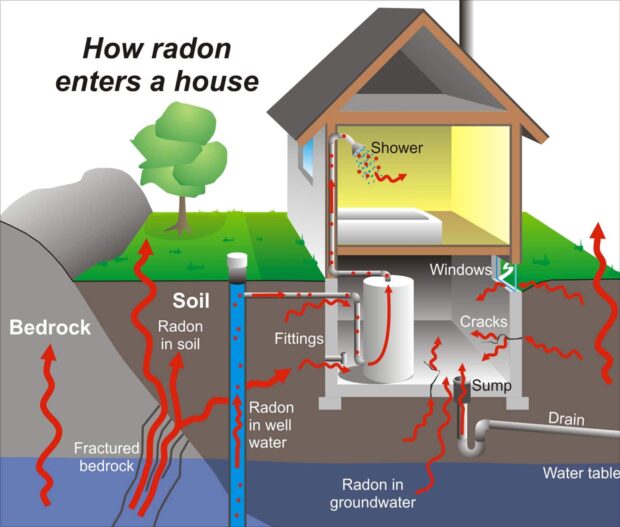
05) Reduce Negative Air Flow
Part of your radon gas removal efforts should be stopping radon gas from even entering your home in the first place. Negative airflow, or pressure, in your house, is when more air leaves your house than is added. It can have many positive aspects including naturally cooling your home. When hot air rises throughout your house and back outside, cooler air from your basement or your first floor will get sucked up and carried through your house. Although this is good for cooling your home in the summer, when the air contains radon gas, it can actually be a bad thing.
Try holding a tissue next to the bottom edge of your basement door and see if it blows out. If you have a drafty basement door, then the radon gas can get pulled upstairs and throughout your home.
Since discovering radon gas in our home, I’ve sealed drafty basement windows with(Amazon link) plastic window shrink film and better insulated our interior basement door with(Amazon link) weatherstrips.
06) Buy A Digital Radon Gas Detector
Similar to a smoke or carbon monoxide detector, a radon gas detector will alert you if radon levels reach dangerous levels. Unfortunately, radon gas detectors aren’t usually sold at hardware stores likes Lowe’s or Home Depot yet. But radon detectors can be easily(Amazon link) purchased online for around $100-$200. It felt very good to watch my radon gas levels drop from 20+ to 1.9 over a few days after I had a contractor help us with our radon gas removal.
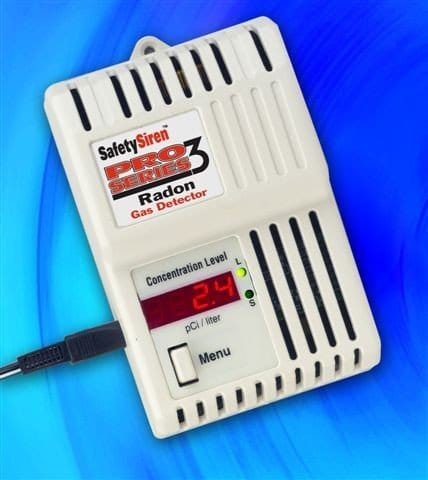
Make sure you read the reviews before you buy a radon gas detector. They aren’t as simple as installing a smoke detector. Some radon detectors require several days to calibrate or need to be serviced on a regular basis.
Learning From My Radon Gas Mitigation & Radon Gas Removal Experience
If you suspect that you might have a radon gas issue then buy a radon gas test kit and start researching radon gas removal ASAP. I’m really glad I saw that radon test on sale in the hardware store. Hopefully, this info on my radon gas mitigation experience helped. Please learn from my mistakes and keep your family safe from radon gas. Good luck!
Everything You Need to Know To Protect Your Family from #RadonGas Share on XRelated Articles:
- Vampire Electronics That Still Cost You Money While Turned Off
- How To Find The Exact Latitude and Longitude of Your House
- 250 People Pick Up An Amish Pole Barn And Take It For A Walk
- Mac vs PC: How To Convince Your Boss You Need A Mac At Work

Frank Wilson is a retired teacher with over 30 years of combined experience in the education, small business technology, and real estate business. He now blogs as a hobby and spends most days tinkering with old computers. Wilson is passionate about tech, enjoys fishing, and loves drinking beer.

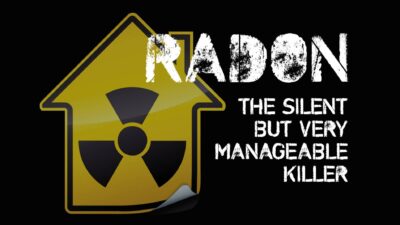










 5 Tactics to Help Make Your Holiday Office Party Amazeballs
5 Tactics to Help Make Your Holiday Office Party Amazeballs
Leave a Reply
You must be logged in to post a comment.